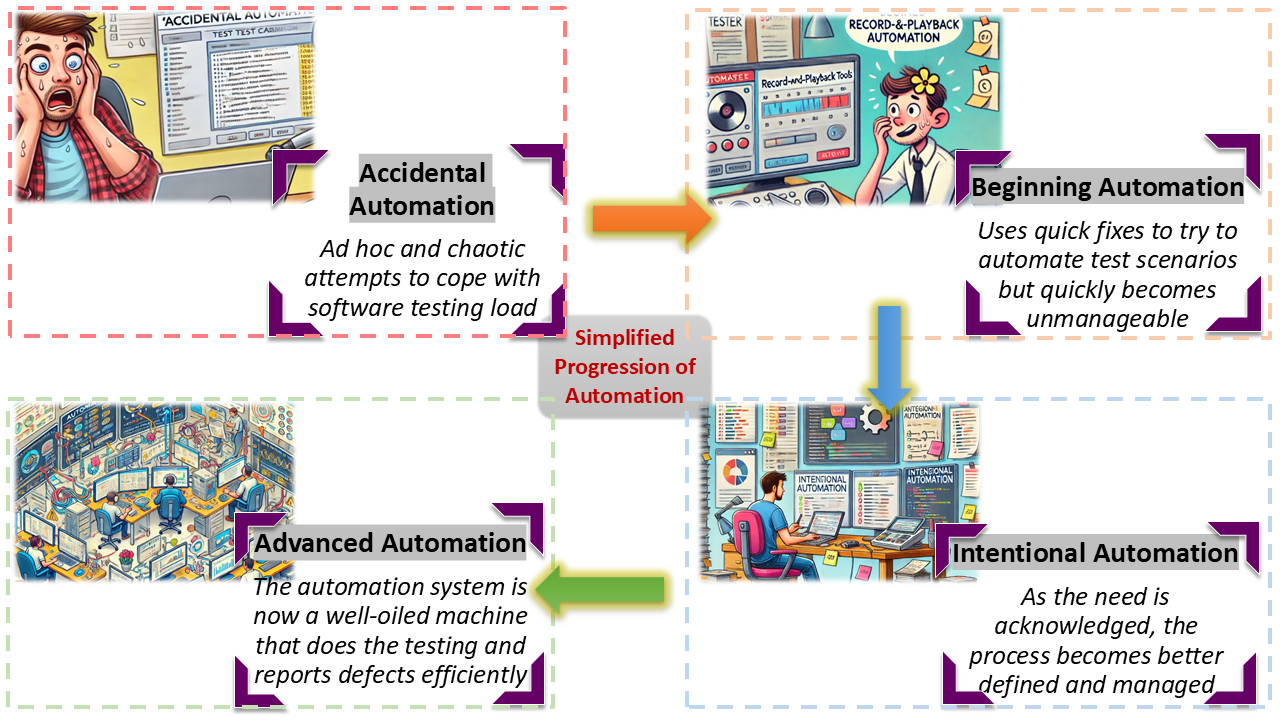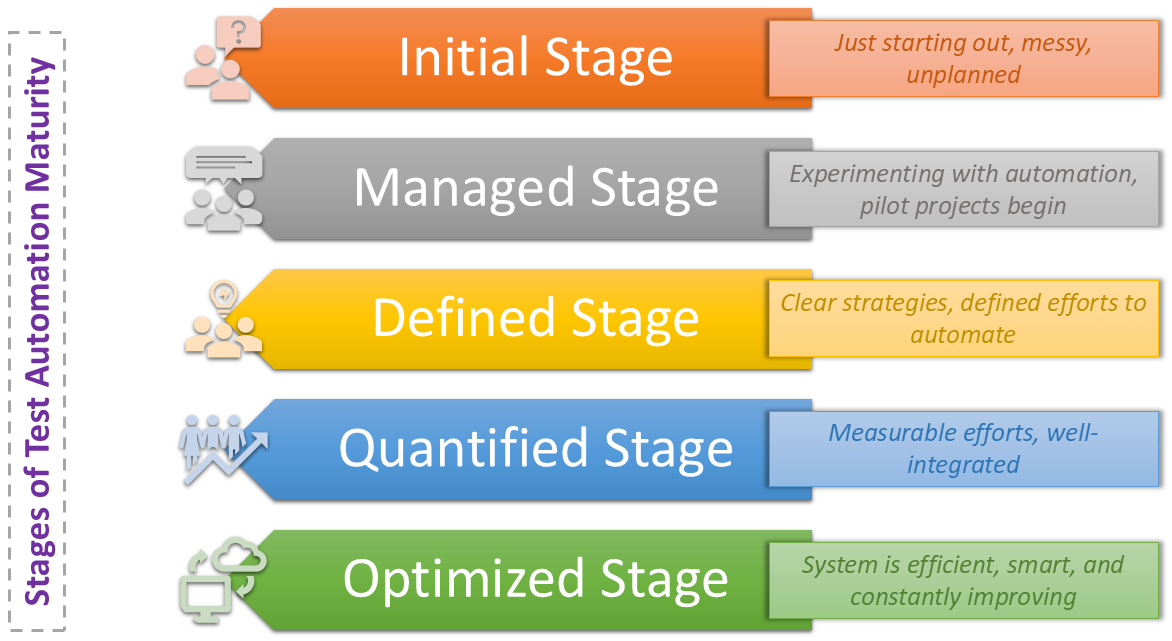Test Automation Maturity Model
|
|
In today’s competitive market, organizations must deliver high-quality software products at lightning speed. Test automation is a powerful tool for achieving this goal. But simply automating tests isn’t enough. To truly optimize your testing efforts and maximize their impact, you need a framework to measure and improve your automation maturity.
Enter the Test Automation Maturity Model (TMM).
Let’s understand the TMM better over here.
What is the Test Automation Maturity Model?
The Test Automation Maturity Model (TMM) is a framework that helps teams and organizations evaluate how advanced or mature their test automation processes are. Think of it as a roadmap that shows where you are in your test automation journey and what steps you can take to improve.
Here’s a simplified explanation of the test automation progression in any organization.

Why do we Need TMM?
Imagine starting with test automation: you write a few scripts here and there, but soon you realize they’re hard to manage, they break easily, and they don’t save you as much time as you hoped. That’s because test automation isn’t just about writing scripts. It’s about creating a reliable and scalable process.
TMM helps you understand how to move from basic, messy attempts at automation to a smooth, efficient system that supports your software development goals. By embracing the TMM, organizations can utilize the full potential of test automation, reduce time to market, minimize defects, and ultimately deliver exceptional software experiences to their users.
Thus, TMM gives you a clear path forward by:
- Showing what’s working and what isn’t in your current automation process.
- Helping you prioritize improvements to save time, reduce costs, and increase the quality of your software.
- Providing you with a common language for teams to discuss and plan automation efforts.
Why is TMM Important?
Without a structured approach, test automation can quickly become chaotic and counterproductive. TMM ensures that:
- You don’t waste time on poorly designed scripts that are hard to maintain.
- Your tests provide meaningful results that help catch issues early.
- Automation becomes a long-term investment rather than a one-time experiment. Read about how to get the best ROI in test automation.
Stages in the Test Automation Maturity Model
If you take a look at this model then you’ll see that it provides a structured approach to assess the current state of your automation practices and identify areas for improvement. For instance, a company at the initial level of maturity might rely on manual testing with sporadic automation efforts. By moving to the defined level, they can establish standardized processes, tools, and frameworks, leading to increased efficiency and consistency. As they progress to higher levels, they can use advanced techniques like continuous integration, continuous delivery, and AI-powered testing to further accelerate their development cycles and enhance software quality. Read about Cost of Quality.
Let’s see each stage closely so you can understand how automation evolves over time.
Stage 1: Initial Stage (Ad Hoc or Reactive)
This is the “just starting out” phase. At this point, automation is messy and unplanned.
What’s Happening?
- Teams automate tests on a whim without a strategy or plan.
- Scripts are created for immediate needs like testing a new feature or fixing a bug.
- There’s no clear understanding of what to automate or why.
Characteristics:
- No dedicated tools or frameworks. Teams use whatever is available.
- Automation scripts are fragile and often break when the application changes.
- It’s hard to scale because everything is done manually or with inconsistent methods.
Example:
Imagine a small team writing a script to test a login form. They don’t think about future updates, so when the UI changes, the script breaks and needs to be rewritten.
Stage 2: Managed Stage (Pilot Projects)
Here, teams start taking test automation seriously, but it’s still in its early days.
What’s Happening?
- Teams begin experimenting with automation tools.
- Pilot projects are used to test the waters – teams automate a few key workflows to see if it saves time.
- There’s still no big-picture strategy, but efforts are a bit more organized.
Characteristics:
- Teams use basic planning to decide which tests to automate (e.g., regression tests).
- Automation coverage is limited to critical areas, such as login or payment features.
- Tools are evaluated, but there’s no standardization yet.
Example:
A team uses Selenium to automate tests for their checkout process. The scripts work well for now, but they aren’t reusable for other parts of the application.
Stage 3: Defined Stage (Strategic Implementation)
This is where automation starts to mature and become more thoughtful.
What’s Happening?
- Teams develop a clear strategy for automation, setting goals and deciding what to automate.
- Tools and frameworks are chosen and standardized across the team.
- Test cases are written with reusability and scalability in mind.
Characteristics:
- Dedicated roles emerge, such test automation engineers who focus on automation full-time.
- Teams automate not just functional tests but also some performance or API tests.
- Collaboration improves between QA, developers, and product managers.
Example:
A team builds an automation framework using TestNG and integrates it with their CI pipeline. They now automate regression, smoke, and some API tests.
Stage 4: Quantified Stage (Scalable Automation)
Now, automation becomes a well-integrated and measurable part of the development process: SDLC.
What’s Happening?
- Automation is integrated into the CI/CD pipeline, so tests run automatically whenever new code is pushed.
- Teams track and use metrics to understand automation’s impact (e.g., how many defects are found, how long tests take).
- Scripts are modular and easier to maintain, so the system can grow without collapsing under its own weight.
Characteristics:
- Automation coverage is broad, spanning functional, performance, and cross-browser/device tests.
- Feedback is fast. Developers get quick reports on the health of their code.
- Teams focus on scalability to make sure the automation setup can handle growing complexity.
Example:
Every time a developer pushes code, automated tests run across multiple browsers and environments. The results are reported back within 30 minutes which helps catch issues early.
Stage 5: Optimized Stage (Continuous Improvement)
This is the pinnacle of test automation. A system that’s efficient, smart, and constantly improving.
What’s Happening?
- Automation is fully optimized and uses advanced technologies like AI/ML to improve itself.
- The system is dynamic, meaning tests adapt to changes in the application with minimal manual effort. Read about self-healing tests.
- Teams focus on continuous improvement by looking for ways to make the process faster and more efficient.
Characteristics:
- Tests are self-healing; when the application changes, the automation updates itself automatically.
- Automation covers all types of testing, including security, performance, and usability.
- The process is data-driven, with insights helping teams predict and prevent issues.
Example:
A generative AI-powered tool like testRigor detects changes in the UI and updates test scripts smartly. Metrics are analyzed to identify weak spots and optimize testing efforts.

How to Apply the Test Automation Maturity Model?
Here are some tips to help you with applying this model to your test automation:
- Evaluate Current Maturity Level: Conduct a thorough assessment of test automation processes, tools, and outcomes. For this, you can use a checklist or diagnostic framework. Some sample questions to ask here: What’s the test coverage? Are tests integrated with CI/CD?
- Define Target Maturity Level: Determine the desired level of maturity based on business goals, application complexity, and team capabilities.
- Develop an Improvement Roadmap: Create a step-by-step plan to move from the current level to the target level. Focus on people, processes, and tools. Also, define clear milestones.
- Implement Changes Incrementally: Roll out improvements in manageable phases to minimize disruption and maximize adoption. Adopt a phased approach to avoid disruptions. For example: Start by automating regression tests before moving to performance tests.
- Measure Progress and Refine: Use metrics to track progress and continuously refine strategies as goals and technologies evolve. Key metrics that you should consider here are test coverage, execution time, and defect detection rate. Utilize continuous feedback loops for refinement.
Choosing the Right Test Automation Tool for TMM
You can significantly improve the status of your test automation if you choose the right tools. These automation tools should
- Support your existing processes
- Integrate into your system
- Be easy to use for your team, that is, suitable to their skill set
- Have a good market reputation
- And fit well within your budget
With AI-powered tools coming into the picture, you are better off choosing one like testRigor.
testRigor is a generative AI-powered test automation tool that can drastically boost your test automation maturity to the next level. It does this by employing AI to reduce test maintenance and test creation efforts.
Through simple English commands, anyone can automate tests way faster than they can while using code in platforms like Selenium. You can automate various types of test cases like regression, UI-based, functional, end-to-end, and even API across platforms and browsers. Since testRigor seamlessly integrates with various platforms and tools, you can perform continuous testing with it.
Summing it Up
You can use the Test Automation Maturity Model to find out how an organization is progressing through different stages of test automation, from disorganized beginnings to advanced, efficient practices. By understanding the different levels of maturity and the key characteristics of each, organizations can benchmark their progress, set clear goals, and implement strategies to achieve higher levels of automation excellence.
| Achieve More Than 90% Test Automation | |
| Step by Step Walkthroughs and Help | |
| 14 Day Free Trial, Cancel Anytime |












